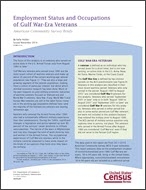
An official website of the United States government
Here’s how you know
Official websites use .gov
A .gov website belongs to an official government organization in the United States.
Secure .gov websites use HTTPS
A lock (
) or https:// means you’ve safely connected to the .gov website. Share sensitive information only on official, secure websites.
-
//
- Census.gov /
- Publications /
- Employment Status and Occupations of Gulf War-Era Veterans
Employment Status and Occupations of Gulf War-Era Veterans
Employment Status and Occupations of Gulf War-Era Veterans
Introduction
The focus of this analysis is on veterans who served on active duty in the U.S. Armed Forces only from August 1990 or later.1
Gulf War-era veterans who served since 1990 are the most recent cohort of wartime veterans and make up about 35 percent of the current working-age veteran population (see Figure 1).2 They are also a large and growing segment of the veteran population, making them a cohort of particular interest, but about which minimal economic research has been done. Much of the past research on post-military economic outcomes of wartime veterans focused on Vietnam-era and World War II veterans. Very few, if any, World War II and Korean War veterans are still in the labor force—none are in the working-age population defined here—and the majority of the Vietnam-era veterans are nearing retirement age.
Veterans who entered the Armed Forces after 1990 also had a substantially different military experience than their predecessors. During the 1990s, significant changes in legislation and policy opened up over 80 percent of the services’ career positions to military servicewomen. The nature of the wars in Afghanistan and Iraq also changed the kind of work done by men and women in the Armed Forces. The occupational experiences of Gulf War-era veterans while in the military could be expected to have some impact on the kinds of occupations they hold once they leave the military.
The data used in this report are from 2011–2013 American Community Survey (ACS) 3-year estimates. This report presents data on the employment situation of noninstitutionalized post-1990 Gulf War-era veterans, 18 to 64 years old, living in the United States. Where appropriate, noninstitutionalized nonveterans 18 to 64 years old are included as a reference group.
There are numerous reasons why veterans and nonveterans have disparate economic outcomes: age, race and Hispanic origin, education, citizenship, and selectivity bias of those pursuing military service being a few.3 These differences and the interactions between these characteristics are not fully explored in this report. However, nonveterans are shown to offer some perspective for this unique population of veterans.
__________
1 According to Title 38, U.S. Code, the Gulf War refers to the entire period beginning on August 2, 1990, and ending “on the date thereafter prescribed by Presidential proclamation or by law.”
2 In this analysis, “working-age” refers to the population 18 to 64 years old.
3 Alfred O. Gottschalck and Kelly A. Holder, “We Want You! The Role of Human Capital in Explaining the Veteran-Non Veteran Earnings Differential” (working paper, U.S. Census Bureau, February 23, 2009).
Others in Series
Publication
Publication
Publication
Share
Related Information
Some content on this site is available in several different electronic formats. Some of the files may require a plug-in or additional software to view.
 Yes
Yes
 No
NoComments or suggestions?


Top

